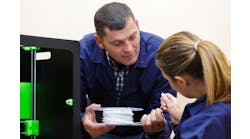Latest from Columnist
I’ve received many queries about use of the open meter and TDR functions on multifunction test sets — and I offer some tips and knowledge in this month’s column.
The Open Meter Function and the TDR Function
The open meter function and the TDR function can quickly show the distance to an open cable pair. Both functions can be used for other purposes, such as finding water in a section of air core PIC cables, identifying and finding split cable pairs, unknown load coils, and more.
Using the Open Meter
Test the pair. Use a volt ohm meter (VOM) to test the conductors of the pair for resistance faults, DC voltage, and induced AC voltage. When such troubles are excessive, an open meter may read long or provide invalid measurements. This may mean that both the open meter and the cable section are not properly grounded.
To test for a good ground, measure any open cable conductor (tip or ring) to ground. Remove the test set ground and remeasure the conductor to ground. The footage measurement should decrease by about one-third. If no change is noted, either the ground is bad or the ground cord on the test set is open.
InvisiLight® Solution for Deploying Fiber
April 2, 2022Go to Market Faster. Speed up Network Deployment
April 2, 2022Episode 10: Fiber Optic Closure Specs Explained…
April 1, 2022Food for Thought from Our 2022 ICT Visionaries
April 1, 2022In reality, the open meter function is a capacitance meter. If you connect to a cable pair and measure the capacitance of the cable pair tip to ring (mutual), it measures the capacitance tip to ring in parallel with the tip to shield and ring to shield in series.
• The test set measures tip and ring to the shield of the cable not to ground.
• The shield should be tied to ground.
• If the shield is not grounded, then the shield to ground capacitance is added to the capacitive measurement.
The test set converts all of that capacitance to feet or meters.
Like resistance, capacitance is proportionate to cable length, and increases with distance. Thus, 1 mile of cable has an average mutual (tip to ring) capacitance of .083 microfarads (µF); .166 µF for 2 miles, and so on.
Mutual capacitance, as tested at the manufacturing plant, can be as high as .090 µF/mile and as low as .076 µF/mile and still be acceptable for customer use.
Measurements of an open in an .090 µF/mile cable with the meter set at the average .083 µF/mile are inaccurate.
• An open at 1,050 feet in .090 µF/mile cable measures at 1,200 feet with the open meter set to .083 µF/mile.
• Measuring in a .076 µF/mile cable, an open at 1,050 feet measures as 950 feet with meter set at .083 µF/mile.
Because of this variance, when digging and/or opening sheath, calibrate the set to the known length.
Unlike resistance, capacitance is hardly affected by gauge or temperature. Gauge capacitance is controlled by the thickness of the insulation at manufacture and temperature has little effect. So, the tip to ring capacitance cannot be trusted as indicator of loop length.
Also, other devices connected to the cable pair add capacitance, and therefore skew the footage readings.
Among them are telephone ringers (electronic and mechanical). How much additional footage depends on the ringer equivalency (RE) of each phone, and how many phones there are connected to the cable pair.
Half ringers: They don’t ring, they are components in the NID that are meant to be detected to prove the loop goes all the way to the NID. Generally, half ringers are no longer used but I mention this because there are still some out there. They can add as much as 1,000 feet to the footage reading. The capacitance of inline filters can add as much as 3,000 feet to the footage readings. Because of these issues, it is best to trust the footage readings tip to ground and ring to ground.
If the tip and ring measurements are different, the shorter of the two readings is to the open. Because we are measuring capacitance to ground, the length of ungrounded conductor beyond the open changes the capacitance of the longer wire. Therefore, its total capacitance is affected, and any measurement along it is inaccurate.
The capacitance per mile for tip and ring to ground is different than tip to ring capacitance of .083 µF/mile for all exchange cables and drop wires. Open meters are also programmed for 25-pair cables and bigger. They are programmed for air-core and filled cable on tip or ring to ground measurements. A good example for an open meter setting is .125 µF for air-core cable and .134 µF for filled cable. The open meter setting for a 6-pair Beldon or Essex drop is .143 µF per mile. The test set manufacturer has provided tip and ring to ground settings for special cables and drop wires.
Cable capacitance is adversely affected by water intrusion (which increases it) and poor bonding (which decreases it). Proper grounding increases the flow of current in the shielding circuit, improving the capacitive performance of the cable. Shield continuity is essential to control capacitive balance for both transmission characteristics and safety.
A technician must have a working knowledge of capacitance in order to efficiently find open and split cable pairs in the field. The problem here is that experts do not agree on exactly how cable capacitance is used in troubleshooting.
• Inward and outward movement in the cable causes most open cable pairs.
• Distribution pairs are borrowed indiscriminately, adding to the problems.
• Mother Nature adds to the challenges by electrolysis and galvanic corrosion of cable pairs.
• Bonds are left open and grounds are removed inadvertently.
Like this Article?
Subscribe to ISE magazine and start receiving your FREE monthly copy today!
Open meter measurements include all laterals, conductor beyond the subscriber, the capacitance of load coils, build-out circuits, any dead wire crossed with the pair, water, purging compound. When looking for an open cable pair, these capacitive anomalies affect any measurement. They don’t appear very often but when they do they must be identified, located using the open meter function along with the TDR, and the RFL functions in order to use the pair for bandwidth.
Signing off
The copper cable technician has many tough challenges, and even with excellent technology and training (which many don’t have), there aren’t easy fixes. I’ve been so honored to work with many excellent technicians who keep plugging away regardless of how tough the job is and how underfunded their role and equipment and training needs are. Thank you to those dedicated techs! Please send me your thoughts about challenges on the job: [email protected], 831.818.3930. P.S. Let’s hope for a much better 2021!









